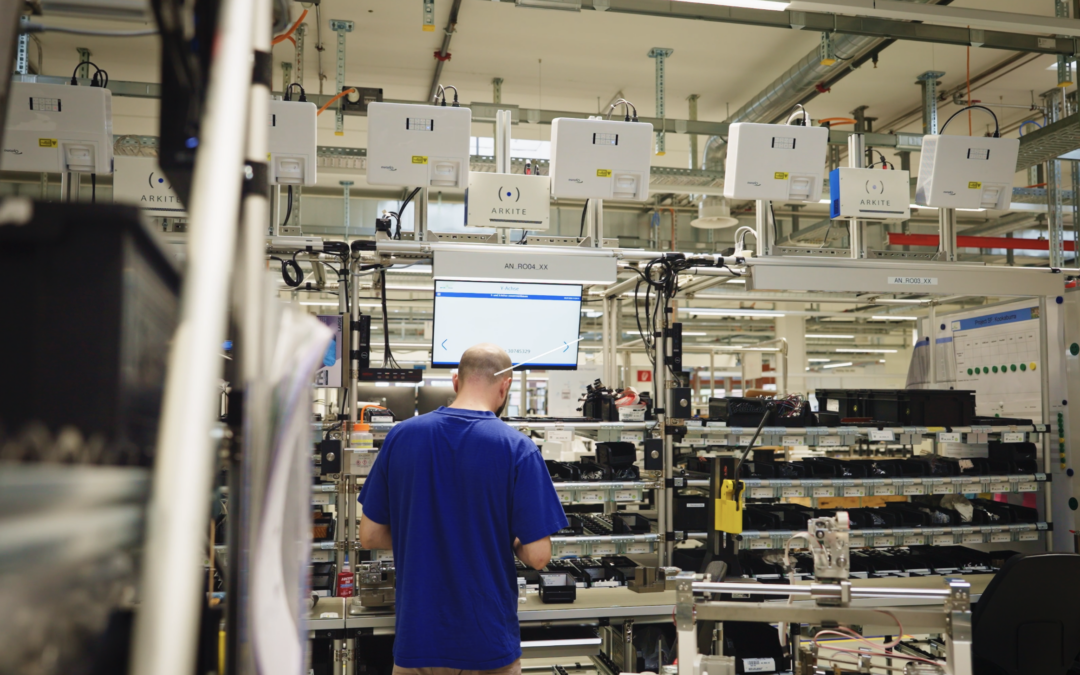The Challenge
At Barco, assembly processes are very complicated. Moreover, at the same workstation, up to 14 different product variants can be assembled. This results in a steep learning curve. It takes a lot of training for an operator to become fully operational. Temporary workforces can hardly be integrated in the production. Even with experienced operators, there is still a significant amount of scrap and rework required.
In order to streamline and orchestrate the manufacturing on the shop floor, Barco has implemented SAP ERP Production Planning and Manufacturing Execution, SAP ME.
Still, a lot of pressure remains on the operator to do assembly tasks faster and with higher quality.
Our Solution

Above each workstation, we installed an Arkite 3D Sensor along with a projector. The purpose of the Arkite 3D Sensor is to guide the operator during the assembly process, using its state-of-the-art Augmented Reality technology. As such, Arkite’s Operator Guidance Platform helped Barco reach the objectives below:
- Operator Guidance
- Process Standardization
- Error Prevention
- Operator Training
To find more about the Arkite Operator Guidance Platform’s added value for each of the aspects above, read the next page.

The Results
Operator Guidance
At the start of the assembly process, the operator selects which of the 14 product variants he needs to assemble. Arkite’s Operator Guidance Platform projects specific step-by-step instructions directly on the workbench and highlights the area where the subsequent action needs to be performed.
This way, the operator doesn’t need to memorize the entire assembly process, nor does he need to constantly keep in mind which product variant he is making.
Arkite’s Operator Guidance Platform helps him to:
- Become operational with less training
- Support multiple product variants sooner
- Work faster
- Make fewer mistakes
Process standardization
Since every operator receives the same instructions in the same order, Arkite’s Operator Guidance Platform also ensures a product is always assembled in exactly the same way.
The assembly process is standardized and operator independent.
Error prevention
Arkite’s Operator Guidance Platform also warns the operator in case of any error in a forward-looking manner. If an operator executes a task at a wrong time or location, he is informed by a colored error projection. In case he tries to use a smart tool, like for example an electric screwdriver, at an improper time or location, Arkite’s Operator Guidance Platform will disable the tool and prevent it from being used.
As a result, the amount of scrap and rework during manual assembly could be drastically reduced.
Operator training
The operator guidance provided by our platform resulted in a reduction of the training time of more than 50%.
Moreover, temporary workforces can now be easily integrated in the production.
In general, operators are able to complete assembly processes a lot faster.
Integrations
Smart tool integration
SAP integration
Since the manufacturing process is orchestrated by SAP ERP and SAP ME, each workstation is also interacting with SAP ME:
- Before the operator uses a part in the assembly process, he first has to scan the part’s barcode.
SAP ME checks whether the part is in the bill of materials for the product variant.
After approval, the operator can continue assembling the product.
- SAP ME also monitors the stock level of all materials.
As the safety stock level is approached, the required stock procurement is triggered in SAP ERP.
- The successful completion of each work step is reported back to SAP ME.
A shop floor manager can see the real-time status of overall assembly task as well as the history of each operator’s assembly process through SAP Manufacturing Execution.
In the current implementation at Barco, there is only one product with multiple variants to be assembled at a workspace. But this is only the start.
Going forward, there is room to optimize production by assembling multiple products each with multiple variants at a single workspace by any operator.
In these kinds of scenarios, the true value of the integration between Arkite and SAP ME comes to fore, when SAP ME sends over guidance worksteps customized to the product-variant-operator combination. This is incredibly powerful.
The Future

Want to know more?
Are you curious about what Arkite Platform can do for your organization?
- Visit our website to learn more about our product and customer references
- Request a free live demo
- To know more about the technology used at Barco, navigate to http://documentation.arkite.com and download our FAQ and Technical Information


